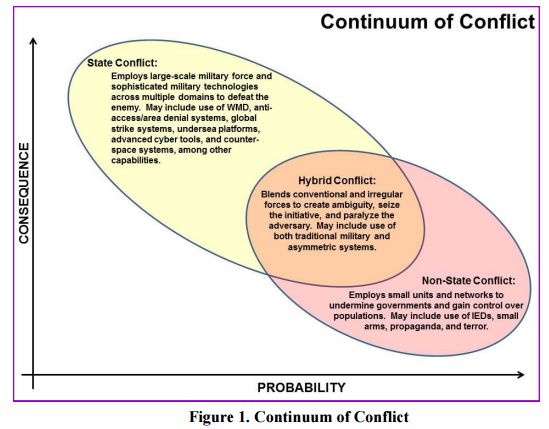Joint Chiefs Outline New Strategy for Fighting ISIS, Other Major Threats

We are more likely to face prolonged campaigns than conflicts that are resolved quickly…that control of escalation is becoming more difficult and more important…and that as a hedge against unpredictability with reduced resources, we may have to adjust our global posture. Despite what is likely to be a difficult future, we are blessed to be able to count on the young Americans who choose to serve, to live an uncommon life, and to defend their fellow citizens. -- Chairman's Foreward (ellipses in original)
The Joint Chiefs of Staff of the United States military branches released a new National Strategy Paper, outlining the changes needed in American military strategy in a changing world.
In particular, as having the most technologically advanced fighting forces in the world, America is having to learn how to fight overwhelming low-tech opponents with a high-tech fighting force.
This is by far not a new strategy, though America has far more experience being on the other side as the underdog. From the Revolution and meeting the world's largest military with insurgent militias, to WWII and fighting sometimes -- such as tank warfare -- better equipment by producing overwhelming numbers of lower-tech models.
From the Cold War on, it was a race to put America on top with the sleekest, most technological, and most powerful military fighting force on the planet.
The overriding doctrine for American defense was the so-called "two theaters strategy," one where America could successfully defend against threats in two separate operational theaters simultaneously.
President George W. Bush further refined this in 2001 with his "1-4-2-1 strategy." This strategy held that it was essential to defend American territory first; to hold our forward deterrent positions in Europe, the Mideast and Southwest Asia, Northeast Asia, and the East Asian littoral; to have a military capable of "swiftly defeating" two adversaries; and, if necessary, to "win decisively" in one theater of operation.
As critics of the time stated, it made for war plans that were meaner, not leaner, referring to the Cold War bloat brought on by a doctrine of only having to face one primary enemy.
The new strategy, currently called the "integrated military strategy," seeks to create a military that is capable of facing a broad array of threats, and have strategies in place to defeat these threats and defend U.S. interests.
The essence of this strategy is demonstrated in the Venn Diagram labelled "Continuum of Conflict" in the report.
Key to this is that the consequences and probabilities of different types of engagements are not seen as on par with each other. Wide-scale war against a superpower would be unlikely, but devastating to America -- while terrorist attacks and insurgencies are very likely, with little true national security risk other than isolated attacks.
This is the first true national military doctrine that places heavy emphasis on the role of the CIA and Special Forces in suppressing non-state conflicts, and an acceptance that overwhelming the insurgents with outright military force has been less effective than previously thought.
The report did not hold back on naming our primary adversaries on the world stage, much to the irritation of a few international media outlets. Russia, Iran, North Korea, and China remain as our top potential state adversaries militarily, but the report was quick to add:
None of these nations are believed to be seeking direct military conflict with the United States or our allies. Nonetheless, they each pose serious security concerns which the international community is working to collectively address by way of common policies, shared messages, and coordinated action.
The greatest threat is seen in the rise of violent extremist organizations (VEOs) that are gaining popularity in the Middle East and North Africa. Far from pulling punches, the report states that our primary strategy for dealing with VEOs must become one of "Disrupt, Degrade, and Defeat."
Where the report differs from current strategy is that this doctrine of "Disrupt, Degrade, and Defeat" the VEOs must not come at the expense of the civilian population -- who are vastly affected by large-scale attacks. Instead, a heavier reliance on small unit (including special forces) contributions helps ensure minimal civilian disruption.
While 2016 will bring in a new commander-in-chief, it is unlikely that the new integrated military strategy will be altered significantly -- short of a willingness of the new administration to conduct widespread occupation of the Middle East to subdue ISIS/ISIL. Instead, this new strategy of meeting the enemy with the type of force most likely to destroy them is going to be the new military policy of the United States for many years to come.




